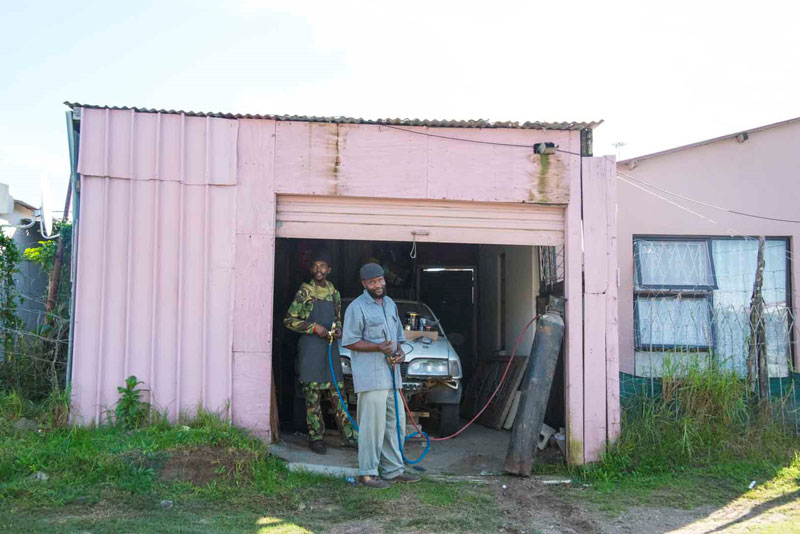[intro]There is compelling evidence that the Southern Cape Coast was an area of thriving human communities from as long ago as our emergence as a distinct hominid species. Researchers show that around 80 000 to 100 000 years ago the first humans beings who inhabited parts of the Cape, were innovative tool makers and about 40 000 years ago our immediate cultural ancestors such as the San arose across all of Southern Africa, including the Cape. The descendants of the San and Khoikhoi peoples formed the first line of defence when Europeans began colonising South Africa.[/intro]
We shall begin with the Khoisan defeat of a significant Portuguese viceroy. In 1510, some Portuguese sailors, led by one Francisco de Almeida, came ashore at the Cape to find food and water. They also decided to help themselves to the cattle livestock of the local Cape Khoisan clans. De Almedia was famous for amongst other things, leading Portuguese naval squadrons, armadas, which broke the power of Swahili-Arab control over the Indian Ocean trade routes and famously destroyed the town of Mombasa in today’s Kenya in 1505. Bear in mind, the Portuguese needed to control these coastal East African ports not just because they were en route to India, but because they were the gateway to the gold trade with the African interior state of Great Zimbabwe.
However, for all de Almedia’s feats in destroying the power of Swahili merchants he would die in a battle with the Khoikhoi who enacted defensive reprisals against the Portuguese crew for the act of cattle theft. For much a period thereafter, Portuguese ships preferred to stop in Angola for refreshment, to avoid the Khoikhoi.
Respectful behaviour towards Africans was important for Europeans to successfully access refreshments at the Cape in those years, because by the time ships rounded that coast to get to the East Indies, their men were in desperate conditions, as historian Cope describes of an English ship that stopped by in 1591:
These sick sailors were likely drinking the waters of the Camissa River which once ran down Table Mountain, but which now runs under the city in tunnels. Historian Patric Tariq Mellet writes in ‘The Camissa Embrace: Odyssey on an Unrecognised People’ that “‘ //amma isa’ speaks of the place of sweet waters, the river with its many tributary springs and, the people whose livelihood was dependent on the river”. Mellet describes the Camissa River as a site of social and economic dynamism and points back to the much older histories of the indigenous societies who lived from the natural wealth of the Cape and southern Africa in general.
The enduring Cape 80 000 year old Cape eco-economy
The Khoisan who decimated de Almeida were an amalgamation of several streams of African cultures who had inhabited southern Africa for thousands of years. These human cultural developments begin 200 000 years ago with the emergence of our species, homo sapiens, and many of the early human families to ever exist were inhabiting that Cape region, living nomadic and migratory lives.
We have compelling evidence that the Southern Cape Coast was an area of thriving human communities from as long ago as our emergence as a distinct hominid species. UNESCO classifies several places in the Cape as critical to our scientific and cultural understanding of human origins.
Researchers show that around 80 000 to 100 000 years ago the first humans beings, inhabiting parts of the Cape, were innovative and treating stone with heat “to enhance its flaking qualities”, engineering by fire, which is considered “a major technological milestone in prehistory since the earliest developments of stone tool-making. It provides the first evidence of a transformative technology, i.e. transforming the physicochemical properties of a material for technical purposes,” according to the study ‘Early evidence for the extensive heat treatment of silcrete in the Howiesons Poort at Klipdrift Shelter’.
This technique of heating rock made it possible for humanity to eventually discover, extract and manipulate metals such as iron, gold and copper. De Almedia could not have known that at the Cape where he died, the early techniques of human fire engineering thrived 80 000 years before him. Fynbos plants were likely used to fuel the intense fires that fed the revolutionary stone-heating process according to botanist and academic Dr Alastair Potts.
The productive development and exchange of ideas amongst those early human families at the Cape involved the organised harvesting of seafood sources, including perlemoen and the hunting of big game. Artistic renditions of the harvesting, hunting and subsisting in the Western Cape from 60 000 years ago can be seen at the African Centre for Coastal Palaeoscience.
At Blombos Cave in the Cape, we find remnants of the earliest human cultural expression in the form of pierced shell beads, engraved stones, and the use of red ochre called imbola.
40 000 year old San cultures and ‘Stone Age Economics’
At some point between 40 000 and 20 000 years ago, our own immediate cultural ancestors such as the San arise across all of Southern Africa, including the Cape. While today we use the name San as a collective name to signify traditions of hunter-gathering African clans, there are diverse San clans across Southern Africa today such as the ‡Khomani, /Xam and Ju/Hoansi, many of whom continue to experience cultural, economic and social marginalisation even though their cultures represent the oldest continuous mode of life in this region for 20 000 years.
While it is not clear how culturally close San cultures of today are with the earliest human communities that thrived in the Cape, what we do know is those early ideas around ochre, fire, and tool making became common practice in Africa and the world, including amongst the San.
About 40 000 years ago, the San cultures had refined the art of tool-making such as producing smaller spearheads with which many of us are familiar. From 25 000 years ago, they added pharmacological knowledge of poison to their hunting arsenal. Scientist Louis Liebenberg argues that living San cultures offer the best historical clues as to how early humans in Africa came to develop scientific techniques.
Adhikari, in ‘The anatomy of a South African genocide: The extermination of the Cape San peoples’ states that
Philosophically and materially, San cultures thrived in what anthropologists today call ‘primitive affluence’, that is a holistic view of life which was lived through minimal accumulation, zero wastage, non-exploitation and healthy human relationships. This was a life free from the pressure to endlessly accumulate, and most important, that did not view the world through the lens of scarcity.
In his book, ‘Stone Age Economics’, Michael Sahlins argues that pre-agricultural economies were not characterised by extreme hardship and brute survivalism, but in fact, by a view of sufficiency and ‘material plenty’ which also allowed a life of leisure. The scarcity model of economics which dominates today, Sahlins argues, is a concept born of industrialism and its drive for competitive accumulation. Thus, without romanticising it, Sahlins points to the philosophical basis of economies that centred sufficiency rather than an imbalanced exploitative dynamic between the producer, the consumer and the natural environments.
Sahlins argues, “Products are homespun: of stone, bone, wood, skin— materials such as ‘lay in abundance around them’” As a rule, neither extraction of the raw material nor its working up takes strenuous effort. Access to natural resources is typically direct – “free for anyone to take”.
The integration of Khoekhoe livestock economy
About 2 000 years ago, another segment of migratory Africans arrived, and introduced to the Cape, the livestock that de Almeida’s men would steal in 1510. These were the Khoikhoi sheepherders who later incorporated cattle, and lived semi-nomadically, erecting semi-permanent reed-mat houses and animal enclosures. They integrated into the landscape of the San hunter gatherers, forming common kinship that allowed the two modes of life to co-exist fluidly, even though over time, the hunter-gatherer communities would be displaced.
This semi-nomadic sheep herding economy, would become deeply entrenched in the southern Cape and also right through into the Eastern Cape.
Oral traditions give an insight into food production practices, as per the extract from M Du Plessis ‘Kora: A Lost Khoisan Language of the early Cape and the Gariep’:
The descendants of these San and Khoikhoi peoples, with the overlapping cultures, that we today call Khoisan, formed the first line of defence when Europeans began colonising South Africa- from the defeat of de Almeida in 1510 and for another 200 years thereafter.
Note: The Masters thesis of Yvette Abrahams is key for non-Khoisan people to understand the intricacies of how this terminology has come to be used outside of the Khoisan community and their self-representation










